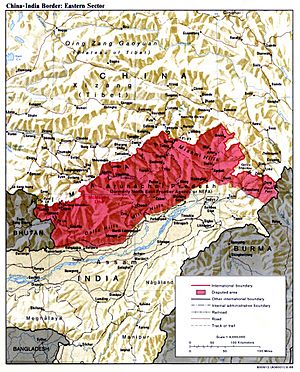McMahon Line facts for kids

The McMahon Line is a special border line drawn on a map. It was part of an agreement called the Simla Convention, which was a treaty signed in 1914 between Britain and Tibet.
Even though some people disagree about whether it's a completely legal border, it currently acts as the real boundary between China and India. This disagreement over the line was one of the main reasons for a war between China and India in 1962.
Contents
What is a Border Line?
A border line, or a demarcation line, is like an invisible fence that shows where one country's land ends and another country's land begins. These lines are very important because they help countries know who owns what land and prevent arguments.
Why Was the McMahon Line Created?
The McMahon Line was drawn during a meeting called the Simla Convention in 1914. At this meeting, representatives from Britain, Tibet, and China met to talk about the borders in the Himalayan region. The British wanted to clearly define the northern border of their Indian Empire, especially in the eastern Himalayas.
Who Drew the Line?
The line was named after Sir Henry McMahon, who was the British foreign secretary in India at the time. He was the main person who drew the line on the map during the Simla Convention. The British and Tibetan representatives agreed to this line as their border.
The Simla Convention of 1914
The Simla Convention was a meeting held in Shimla, a city in India. The main goal was to settle border issues and the political status of Tibet. Britain and Tibet signed an agreement that included the McMahon Line as the border between India and Tibet. However, China did not fully agree to the convention, which has led to problems later on.
Why is the Line Disputed?
China does not accept the McMahon Line as a legal border. They say that Tibet was not an independent country when the treaty was signed in 1914, and therefore, Tibet did not have the power to make such an agreement with Britain. India, on the other hand, considers the McMahon Line to be the official and legal border. This disagreement has caused tension between the two countries for many years.
The 1962 War
The dispute over the McMahon Line and other border areas led to a short but intense war between China and India in 1962. Both countries claimed control over certain parts of the border, especially in the Arunachal Pradesh region, which is on the Indian side of the McMahon Line. The war ended with China declaring a ceasefire and withdrawing its troops, but the border dispute remains unresolved.
Related pages
- GlobalSecurity.org, India-China Border Dispute
- Kawaguchi, Yuki. "Arunachal Pradesh Territorial Dispute between India and China," ICE Case Studies (US). No. 161, November, 2005.
Images for kids
-
Map of "The Indian Empire and surrounding countries", from Imperial Gazetteer of India, shows the "Outer line" as the boundary between British India and the Chinese Empire.
See also
 In Spanish: Línea McMahon para niños
In Spanish: Línea McMahon para niños










